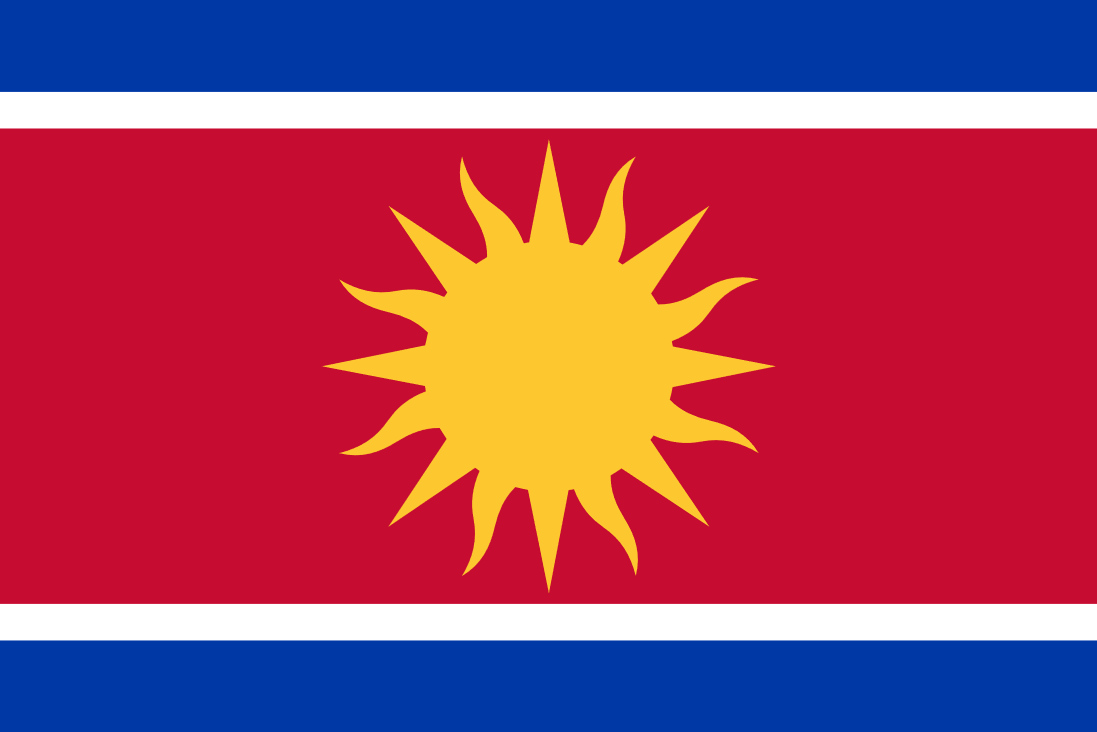Akarean Union: Difference between revisions
No edit summary |
mNo edit summary |
||
| Line 30: | Line 30: | ||
|languages_type = Other common languages | |languages_type = Other common languages | ||
|languages = Oseanian, Edofasian | |languages = Oseanian, Edofasian | ||
|ethnic_groups = 58.4% Huan Akarean | |ethnic_groups = *58.4% Huan Akarean | ||
*9.3% Hykkogwa | |||
*12.7% Gaanglanglataal | |||
*10.4% Satoyaman | |||
*3.3% White Terran | |||
*3.1% Suilander | |||
*2.4% White Kaltach | |||
*0.4% Other | |||
|ethnic_groups_year = <!--Year of ethnic groups data (if provided)--> | |ethnic_groups_year = <!--Year of ethnic groups data (if provided)--> | ||
|ethnic_groups_ref = <!--(for any ref/s to associate with ethnic groups data)--> | |ethnic_groups_ref = <!--(for any ref/s to associate with ethnic groups data)--> | ||
| Line 36: | Line 43: | ||
|religion_year = <!--Year of religion data (if provided)--> | |religion_year = <!--Year of religion data (if provided)--> | ||
|religion_ref = <!--(for any ref/s to associate with religion data)--> | |religion_ref = <!--(for any ref/s to associate with religion data)--> | ||
|demonym = '''Akarean''' | |demonym = '''Akarean''' | ||
*Huanese | |||
*Hykkogwa | |||
*Gaanglanglataal | |||
*Suilander | |||
|government_type = Unicameral parliamentary socialist democracy | |government_type = Unicameral parliamentary socialist democracy | ||
|leader_title1 = Governor | |leader_title1 = Governor | ||
Revision as of 02:07, 18 March 2025
The People's Democratic Union of Akarean States 福国人民民主联邦 | |
|---|---|
| Motto: 蓝天 金日 满地红 Blue Sky, Gold Sun, Wholly Red Earth | |
| Anthem: The Labourers' Call to Arms | |
| Status | Current |
| Capital | Fujing 8'11°S 96'31°E |
| Official languages | Mandarin, Hykkogwa, Gaanglanglataal |
| Other common languages | Oseanian, Edofasian |
| Ethnic group(s) |
|
| Demonym(s) | Akarean
|
| Government | Unicameral parliamentary socialist democracy |
• Governor | Sun Lu-Tsi |
• Deputy Governor | Masayoshi Kurosawa |
| Legislature | The Great Assembly |
| Establishment | |
• The Labourers' Revolution | 1883 - 1886 |
• The Great Referendum | April - August 1886 |
• The Acts of Union | November & December 1886 |
| Population | |
• 2015 census | |
| Currency | Yuan Currency code |
| Time zone | West Akarea Time Fujing Time Hautsing Time |
| Calling code | +86 |
| Country code | AKU |
| Internet TLD | .ak |
The Fúguó Union (福国联邦; "Fú guó liánbāng"), officially the Union of Akarea or Akarean Union, is a large oriental nation straddling the equator in Akarea. It is a union of the governments of seven states, almost all of the former territories of the Akarean Empire: Fujing, Great Huan, Suiland, Gaanglanglataar, Bantang and West Satoyama. As the most populated and most densely populated nation, the largest export economy and one of the largest standing militaries in the world, the Akarean Union is considered one of the great global superpowers.
The capital of Akarea is Fujing. Although Fujing is physically located within Great Huan, it is considered its own state for administrative purposes, as the Grand Assembly where the governments of Akarean states meet is located there. Fujing is the most populated and most densely populated city in the world, with some areas reaching the equivalent of 1.3 million people per square kilometre. The terrain of Akarea varies from lowland plains and rolling hills to jungles, rugged coastlines, steep mountain ranges and high plateaus. The northern two-thirds of Great Huan and the entirety of Suiland lie on the South Kaltach Fault, which makes these regions prone to destructive earthquakes and tsunamis.
The first known human inhabitants in Akarea date back several million years, in the Yáolán or "Cradle" immediately south of the Cenaesian Mountains. By the 3rd millennium BCE, the earliest dynastic civilisations had emerged along the fertile coastlines of the southernmost peninsula of the Kaltachian continent. The events of Year 0 led to a breakdown in the authority of these dynasties, leading to the Era of Warring States which would last for over five centuries. When early irrigation methods were discovered by farmers of the Huan dynasty around 400 CE, Huan's ability to feed its troops and their families reliably directly led to a vast strategic and manpower advantage over the other states, leading to a decisive Huan victory as the dynasty overtook the entire peninsula, establishing Great Huan. Over the next 1000 years, the Huan emperors would continue to expand, developing one of the earliest navies in the world and embarking on the Nine Great Campaigns which saw the occupation of neigbouring nations Gaanglanglataar, Satoyama, Suiland, Hautsing and a significant portion of Hykko, now spanning the entire region of Akarea and morphing into the Akarean Empire.
After being introduced to Candanadium around the 1760s, the thrones of the Akarean Empire and Candanadium became formal allies, and trade routes were established between Akarea and Kaltachia. Following the Industrial Revolution in the Akarean Empire, civil unrest grew as workers grew dissatisfied with long hours and poor pay. They formed the People's Army and started The Labourers' Revolution, fighting for two years against imperial resistance before sieging the Grand Imperial Palace, culminating in the Grand Rebellion where almost one million civilians torched the palace to the ground and shot the emperor Zhou Huan in what is considered to be the most attended public execution in history. The surviving royalty and noblemen fled Akarea, leaving the People's Army victorious and now in control of all the former territories of the Empire. They immediately disbanded the Empire and founded a new socialist union, extending invites to all the former territories. All accepted this invitation except for Satoyama, leading to the Division of Satoyama in which its eastern portion formed an independent republic.
The Akarean Union is a unicameral parliamentary democracy; elected delegates from the Akarean States meet in the Grand Assembly to discuss local and national issues. Akarea's system of Market Socialism is defined in the People's Definition of the New Akarean State, and the Union's Constitution protects it, stating that workers control the means of production and the enterprise which stems from it. The currency of Akarea is the Yuan (lit. "Unit") as part of the People's Definition of the New Akarean Economy in which the structure of a Renminbi or People's Currency is outlined. The Akarean Union is not a member of either the Kaltach Union or Terran Commonwealth, though it has formal relations with both Candanadium and Edofasia, the principal members of these unions relatively, which has been a point of contention throughout the Akarean Union's contemporary geopolitical history. Akarea is known for its cuisines, both traditional and pop culture, and contains nearly 100 designated world heritage sites, the most of any non-aligned nation.
This section needs expansion. You can help by adding to it or discussing it. |
Etymology
This section needs expansion. You can help by adding to it or discussing it. |
History
Main articles: History of the Akarean Union, History of the Akarean Empire, List of Akarean Dynasties, The Labourers' Revolution, The Eight Acts of Union
This section needs expansion. You can help by adding to it or discussing it. |
Geography
This section needs expansion. You can help by adding to it or discussing it. |
Government & Politics
This section needs expansion. You can help by adding to it or discussing it. |
Economy
This section needs expansion. You can help by adding to it or discussing it. |
Infrastructure
This section needs expansion. You can help by adding to it or discussing it. |
Demographics
This section needs expansion. You can help by adding to it or discussing it. |
Culture
This section needs expansion. You can help by adding to it or discussing it. |
Notes
No notes


